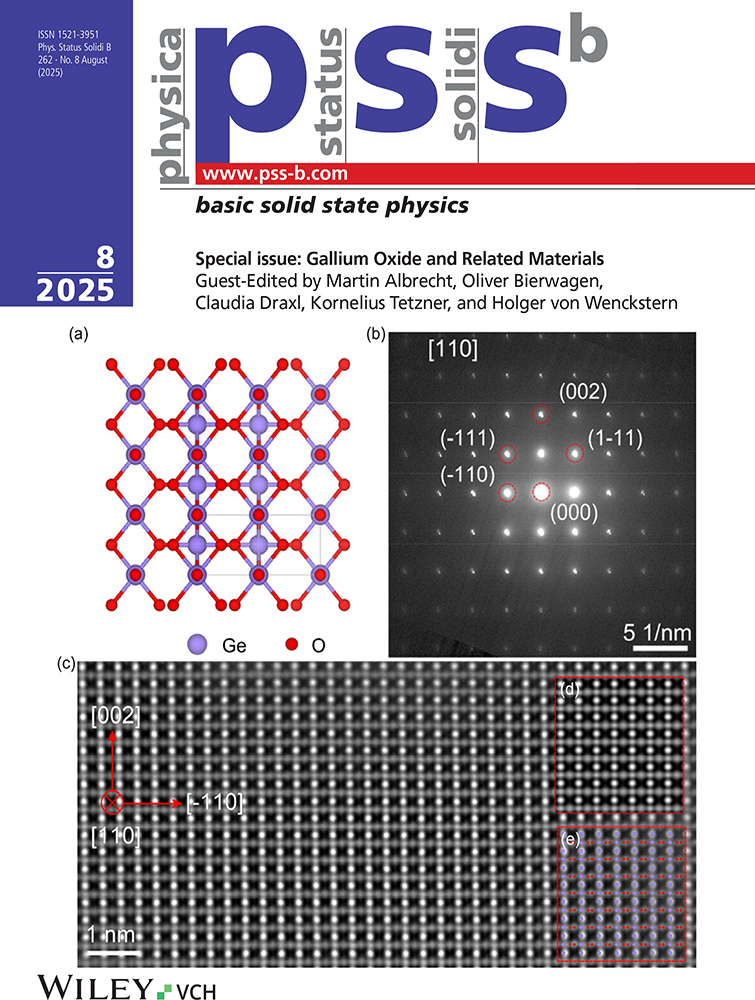Isotope Effect in the Mott Transition; a Prediction on the Basis of Molecular All-Quantum Simulations
M.C. Böhm
Institut für Physikalische Chemie, Physikalische Chemie III, Technische Universität Darmstadt, D-64287 Darmstadt, Germany
Search for more papers by this authorJ. Schulte
Bruker Analytik GmbH, Silberstreifen, D-76287 Rheinstetten, Germany
Search for more papers by this authorR. Ramírez
Instituto de Ciencia de Materiales, Consejo Superior de Investigaciones Cientifícas, Campus Cantoblanco, E-28049 Madrid, Spain
Search for more papers by this authorE. Hernández
Instituto de Ciencia de Materiales, Consejo Superior de Investigaciones Cientifícas, Campus de la Universidad Autonoma, Bellaterra, E-08193 Barcelona, Spain
Search for more papers by this authorM.C. Böhm
Institut für Physikalische Chemie, Physikalische Chemie III, Technische Universität Darmstadt, D-64287 Darmstadt, Germany
Search for more papers by this authorJ. Schulte
Bruker Analytik GmbH, Silberstreifen, D-76287 Rheinstetten, Germany
Search for more papers by this authorR. Ramírez
Instituto de Ciencia de Materiales, Consejo Superior de Investigaciones Cientifícas, Campus Cantoblanco, E-28049 Madrid, Spain
Search for more papers by this authorE. Hernández
Instituto de Ciencia de Materiales, Consejo Superior de Investigaciones Cientifícas, Campus de la Universidad Autonoma, Bellaterra, E-08193 Barcelona, Spain
Search for more papers by this authorAbstract
We have linked an ab initio Hartree-Fock Hamiltonian to the Feynman path integral quantum Monte Carlo formalism in order to derive electronic expectation values under consideration of nuclear degrees of freedom. This approach yields electronic expectation values which depend on the atomic masses. On the basis of combined path integral – ab initio calculations we predict an isotope effect in the correlation driven Mott transition. The nuclear degrees of freedom lead to an enhancement in the electronic correlation strength, an effect which supports the transition conditions. This enhancement is negatively correlated with the atomic masses. Implications of an isotope effect in the Mott transition for the explanation of the superconducting pairing are mentioned concisely.
References
- [1] N.F. Mott, Proc. Roy. Soc. A 62 416 (1949).
- [2] N.F. Mott, Metal Insulator Transitions, Taylor & Francis, London 1990.
- [3] J. Hubbard, Proc. Roy. Soc. A 276 238 (1963).
- [4] J. Hubbard, Proc. Roy. Soc. A 277 237 (1964).
- [5] J. Hubbard, Proc. Roy. Soc. A 281 401 (1964).
- [6] W. Borrmann, A.M. Oles, F. Pfirsch, P. Fulde, and M.C. Böhm, Chem. Phys. 106 11 (1986).
- [7] J. Schütt and M.C. Böhm, J. Am. Chem. Soc. 114 7252 (1992).
- [8] E.H. Lieb and F.Y. Wu, Phys. Rev. Lett. 20 1445 (1968).
- [9] L.F. Mattheis, Phys. Rev. 181 987 (1969).
- [10] W.F. Brinkman and T.M. Rice, Phys. Rev. B 2 4302 (1970).
- [11] L.G. Canon and G. Kemeny, Phys. Rev. B 4 150 (1971).
- [12] M. Cyrot, J. Physique 33 125 (1972).
- [13] M.-H. Whangbo, J. Chem. Phys. 70 4963 (1979).
- [14] A. Georges and G. Kotliar, Phys. Rev. B 45 6479 (1992).
- [15] A. Georges and W. Krauth, Phys. Rev. Lett. 69 1240 (1992).
- [16] X.Y. Zhang, M.J. Rozenberg, and G. Kotliar, Phys. Rev. Lett. 70 1666 (1993).
- [17] M. Rasetti, Lecture Notes in Chemistry, Ed. C. Pisani, Springer-Verlag, Berlin 1996 (p. 289).
- [18] D. Adler, Solid State Phys. 21 1 (1968).
- [19] J.S. Miller and A.J. Epstein, Prog. Inorg. Chem. 20 1 (1976).
- [20] J.B. Torrance, Chemistry and Physics of One-Dimensional Metals, Ed. H. J. Keller, Plenum Press, New York 1977 (p. 137).
- [21] M. Tinkham, Introduction to Superconductivity, McGraw-Hill Publ. Co., New York 1975.
- [22] J. Schütt, M.C. Böhm, and R. Ramírez, Chem. Phys. Lett. 248 379 (1996).
- [23] R. Ramírez, J. Schulte, and M.C. Böhm, Chem. Phys. Lett. 275 377 (1997).
- [24] M.C. Böhm, R. Ramírez, and J. Schulte, Chem. Phys. 227 271 (1998).
- [25] J. Schulte, M.C. Böhm, and R. Ramírez, Mol. Phys. 93 801 (1998).
- [26] R. Ramírez, E. Hernández, J. Schulte, and M.C. Böhm, Chem. Phys. Lett. 291 44 (1998).
- [27] G. Cicotti, D. Frenkel, and I.R. McDonald, Simulations of Liquids and Solids, North-Holland Publ. Co., Amsterdam 1987.
- [28] P.E. Blochl, C. Joachim, and A.J. Fisher, Computations for the Nano Scale, Kluwer, Dordrecht 1983.
- [29] R. Car and M. Parrinello, Phys. Rev. Lett. 55 2471 (1984).
- [30] R.N. Barnett and U. Landman, Phys. Rev. B 48 2081 (1993).
- [31] H.-P. Cheng, R.N. Barnett, and U. Landman, Chem. Phys. Lett. 237 161 (1995).
- [32] R.M. Valladares, A.J. Fisher, and W. Hayes, Chem. Phys. Lett. 242 1 (1995).
- [33] R.P. Feynman and A.R. Hibbs, Quantum Mechanics and Path Integrals, McGraw-Hill Publ. Co., New York 1965.
- [34] R.P. Feynman, Statistical Mechanics, Benjamin Inc., New York 1972.
- [35] H. Kleinert, Pfadintegrale, Wissenschaftsverlag, Mannheim 1993.
- [36] K. Karasawa, S. Dasgupta, and W.A. Goddard III, J. Phys. Chem. 95 2260 (1991).
- [37] D. Porezag, T. Frauenheim, T. Köhler, G. Seifert, and R. Kaschner, Phys. Rev. B 51 12947 (1995).
- [38] C.M. Goringe, D.R. Bowler, and E. Hernández, Rep. Prog. Phys. 60 1447 (1997).
- [39]
M.W. Schmidt, K.K. Baldridge, J.A. Boatz, S.T. Elbert, M.S. Gordon, J.H. Jensen, S. Koseki, N. Matsunaga, K.A. Nguyen, J. Su, T.L. Windus, M. Dupuis, and J.A. Montgomery, J. Comput. Chem. 14 207 (1993).
10.1002/jcc.540141112 Google Scholar
- [40] M.C. Böhm and C. Saal, Z. Naturf. 54a 718 (1999).




